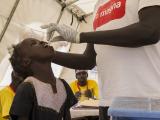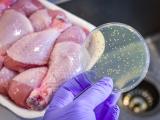Oct 27, 2006 (CIDRAP News) Six more samples of the Escherichia coli O157:H7 strain that killed 3 people and sickened more than 200 who ate raw spinach have been found on a ranch in California's Salinas Valley area, state and federal officials announced yesterday.
In a press conference, Kevin Reilly, deputy director of prevention services for the California Department of Health Services, said the newly identified matching samples are from creek water, a wild boar, and four pieces of cow manure. All samples are from the same farm where investigators had already found three manure samples with E coli that matched the outbreak strain, bringing the total to nine.
Food and Drug Administration (FDA) officials had previously traced the tainted spinach to one infected lot that contained spinach from four different farms in Monterey and San Benito counties. Reilly said sampling from the other three ranches has turned up E coli O157:H7, but it is not the strain linked to the nationwide outbreak. Reilly said E coli O157:H7 is not an unusual finding around cattle and other ruminant species such as deer. A total of 750 environmental samples have been taken so far from the four farms, he said.
According to the most recent FDA tally, the outbreak sickened 204 people, killed 3, and spanned 26 states and one Canadian province. Thirty-one patients developed hemolytic uremic syndrome, a serious kidney condition, and 104 were hospitalized.
Reilly said all evidence indicates that the outbreak is over, though some illness cases are still under investigation.
The ranch where all the matching samples have been found consists of a pasture where cattle graze and a spinach growing area that is fenced off from the pasture. Investigators found areas where the fence was broached, with animal tracks leading from the pasture onto the spinach fields. He said all the positive samples were from the pasture area, located within a half-mile of the spinach field.
Reilly said that the close proximity of cattle operations to growing areas is not unusual in the area where the four ranches are located.
Thats where the investigation is centered right now: how it moved from the pasture and onto the [spinach] field, Reilly said. Theres evidence that the [wild] pigs could be one of the means, but were still investigating.
The wild boar sample that tested positive for the outbreak strain was taken from the gut of a boar that had been killed on the property, he said, adding that pigs can be colonized with O157:H7, but researchers dont fully understand the ecology of the organism in pigs.
The stream that the positive water sample came from is within a mile of wells used for irrigation, Reilly said. Investigators are trying to determine if the O157:H7 in the stream contaminated the aquifer that supplies irrigation water.
In related developments, the FDA in an Oct 20 update said it was reviewing a petition to permit the irradiation of multi-ingredient foods, including prepackaged fresh produce such as fresh spinach, to control contamination. The agency said the food industry must examine the suitability and efficacy of irradiation on a product-by-product basis.


















